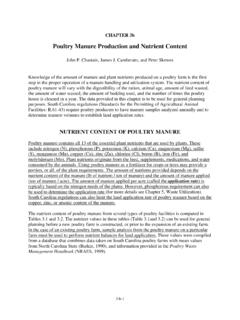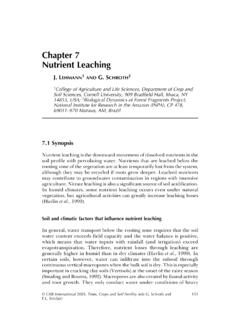Transcription of Functions of Phosphorus in Plants - IPNI
1 Phosphorus is one of 17 nutrients essen-tial for plant growth. Its Functions cannotbe performed by any other nutrient , andan adequate supply of P is required for opti-mum growth and reproduction. Phosphorus isclassified as a major nutrient , meaning that itis frequently deficient forcrop production and isrequired by crops in relative-ly large amounts. The total Pconcentration in agriculturalcrops generally varies to and Transport of PhosphorusPhosphorus enters theplant through root hairs, roottips, and the outermost layersof root cells.
2 Uptake is alsofacilitated by mycorrhizal fungi that grow inassociation with the roots of many is taken up mostly as the primaryorthophosphate ion (H2PO4-), but some is also absorbed as secondary orthophosphate(HPO4=), this latter form increasing as the soilpH increases. Once inside the plant root, P may bestored in theroot or trans-ported to theupper portionsof the plant. Through various chemical reac-tions, it is incorporated into organic com-pounds, including nucleic acids (DNA andRNA), phosphoproteins, phospholipids, sugarphosphates, enzymes, and energy-rich phos-phate example, adenosinetriphosphate (ATP).
3 It is in these organicforms as well as the inorganic phosphate ionthat P is moved throughout the plant, where itis available for further Energy ReactionsPhosphorus plays a vital role in virtuallyevery plant process that involves energy trans-fer. High-energy phosphate, held as a part ofthe chemical structures of adenosine diphos-phate (ADP) and ATP, is the source of energythat drives the multitude ofchemical reactions within theplant. When ADP and ATPtransfer the high-energyphosphate to other molecules(termed phosphorylation), thestage is set for many essentialprocesses to most important chem-ical reaction in nature is pho-tosynthesis.
4 It utilizes lightenergy in the presence ofchlorophyll to combine carbon dioxide andwater into simple sugars, with the energybeing captured in ATP. The ATP is then avail-able as an energy source for the many otherreactions that occur within the plant, and thesugars are used as building blocks to produceother cell structural and storage TransferPhosphorus is a vital component of thesubstances that are building blocks of genesand chromosomes. So, it is an essential part ofthe process of carrying the genetic code fromone generation to the next, providing the blueprint for all aspects of plant growth adequate supply of P is essential tothe development of new cells and to the transfer of the genetic code from one cell to 6 Better Crops/Vol.
5 83 (1999, No. 1) Functions of Phosphorus in PlantsPhosphorus (P) is vital toplant growth and is found inevery living plant cell. It isinvolved in several key plantfunctions, including energytransfer, photosynthesis,transformation of sugarsand starches, nutrientmovement within the plantand transfer of geneticcharacteristics from onegeneration to the = Carbon Dioxide + Water Sunlight Oxygen + CarbohydratesPhosphate Energyanother as new cells are formed. Large quan-tities of P are found in seeds and fruit where itis believed essential for seed formation is also a component ofphytin, a major storage form of P in 50 percent of the total P in legumeseeds and 60 to 70 percent in cereal grains isstored as phytin or closely related inadequate supply of P can reduce seedsize, seed number, and TransportPlant cells can accumulate nutrients atmuch higher concentrations than are presentin the soil solution that surrounds them.
6 Thisallows roots to extract nutrients from the soilsolution where they are present in very of nutrients within the plantdepends largely upon transport through cellmembranes, which requires energy to opposethe forces of osmosis. Here again, ATP andother high energy P compounds provide theneeded DeficiencyAdequate P allows the processesdescribed above to operate at optimum ratesand growth and development of the plant toproceed at a normal P is limiting, the most strikingeffects are a reduction in leaf expansion andleaf surface area, as well as the number ofleaves.
7 Shoot growth is more affected than rootgrowth, which leads to a decrease in the shoot-root dry weight ratio. Nonetheless, root growthis also reduced by P deficiency, leading to lessroot mass to reach water and , inadequate P slows theprocesses of carbohydrate utilization, whilecarbohydrate production through photosyn-thesis continues. This results in a buildup ofcarbohydrates and the development of a darkgreen leaf color. In some Plants , P-deficientleaves develop a purple color, tomatoes andcorn being two examples.
8 Since P is readilymobilized in the plant, when a deficiencyoccurs the P is translocated from older tissuesto active meristematic tissues, resulting infoliar deficiency symptoms appearing on theolder (lower) portion of the plant. However,such symptoms of P deficiency are seldomobserved in the than loss of yield. Other effects of P deficiency on plantgrowth include delayed maturity, reducedquality of forage, fruit, vegetable, and graincrops, and decreased disease resistance. Better Crops/Vol. 83 (1999, No.)
9 1)71975 to 1979 (Figure 1). Consumptiondeclined to an average of million tonsyearly during the 1985-1989 period, buthas since begun increasing, averagingabout million tons since led the in phosphate con-sumption in 1997, followed by Iowa,Minnesota and Texas (Table 3). Others inthe top 10 consuming statesincluded Nebraska, California,Indiana, Kansas, Missouri, andNorth Dakota. These 10 statesaccounted for 55 percent phosphate consumption offertilizer phosphate followedsimilar trends to the , butreached a high of 798,164 tons of P2O5in1985 (Figure 1).
10 Consumption declined to637,175 tons in 1991, but has sinceincreased to 775,370 tons in 1997. About75 percent of Canada s phosphate con-sumption occurs in the prairie provinces(Alberta, Manitoba and Saskatchewan). 6,0005,0004,0003,0002,0001,00001,0008006 0040020001960 1964 1968 1972 1976 1980 1984 1988 1992 consumption, '000 tonsCanadian consumption,'000 of P2O5in North (continued from page 5)








